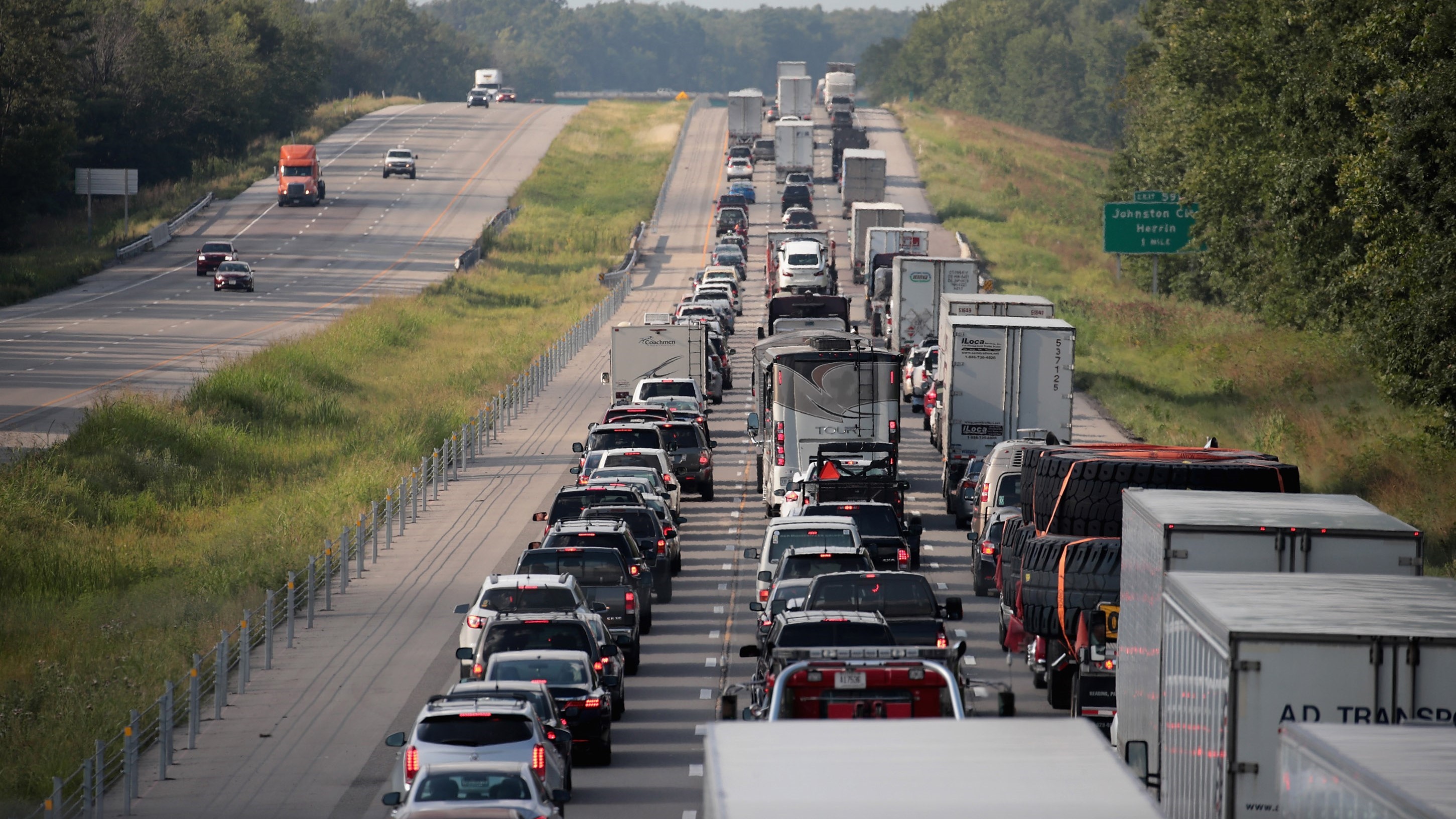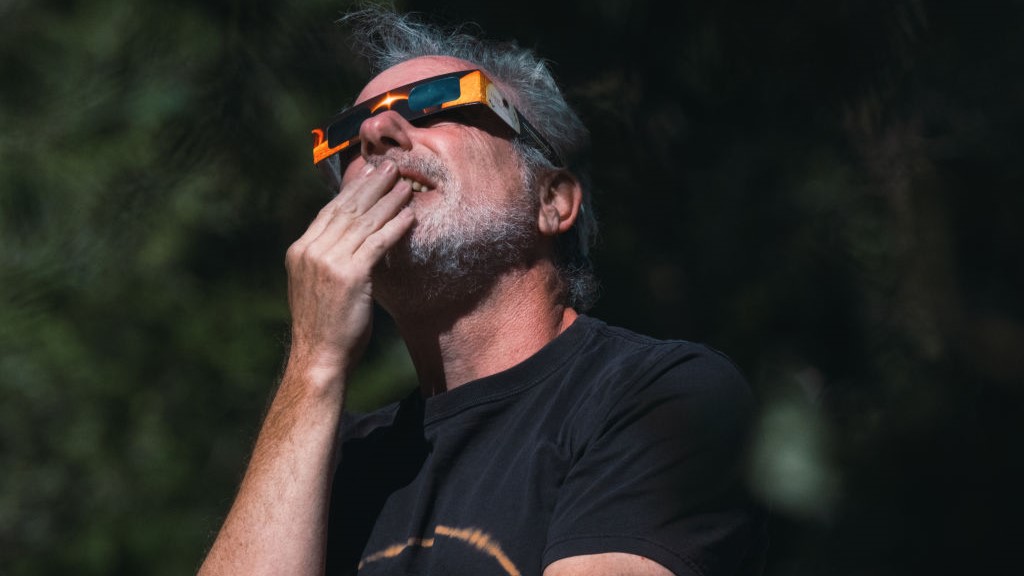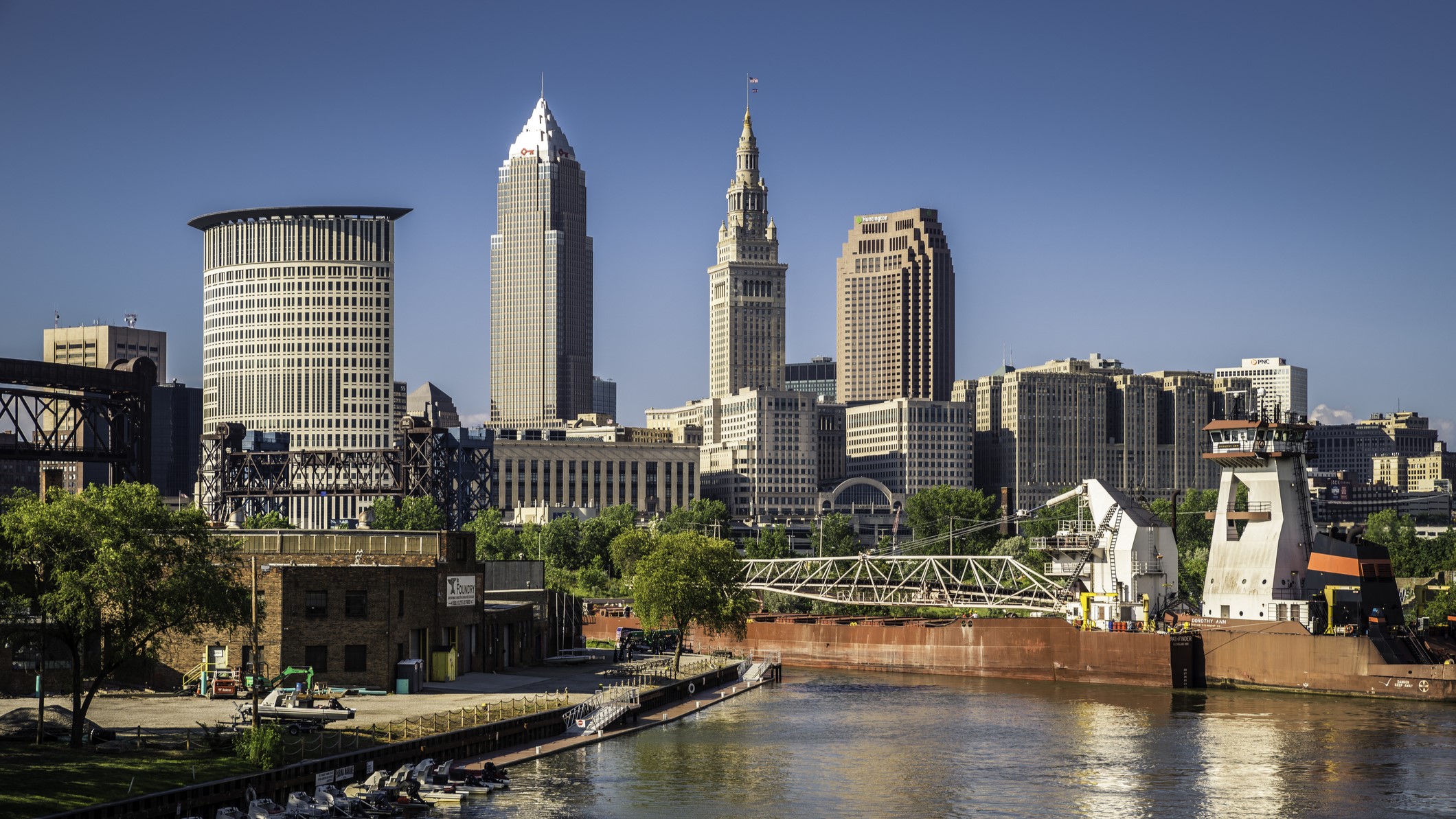Solar eclipse jam: How to avoid getting stuck in traffic on April 8, 2024
Expect a traffic jam for the ages on eclipse day — and plan ahead to avoid it.

Buckle up — there's a total solar eclipse coming on April 8 — and everyone will be talking about traffic.
Many who traveled into and within the path of totality last time around on August 21, 2017, will recall the long and tedious traffic jams on the way home after the eclipse.
The total solar eclipse on April 8, will traverse North America from Mexico to Canada via the U.S. Although another one happened less than seven years ago, this one is longer in duration, has a wider path of totality, and occurs over or close to many major cities. It will also happen in a part of the world where millions of people have either experienced or heard eyewitness accounts of how spectacular totality is. The potential is for millions of visitors to flock to the path of totality, defying predictions.
Related: How will the 2024 total solar eclipse differ from the 2017 total solar eclipse?
Complicating matters will be the uncertain weather prospects, which are more likely to mean cloudy skies in April than in August. Will that put people off? Or merely add to traffic in the hours before the eclipse? A massive influx of visitors into rural areas could cause issues, clogging highways and parking lots, and you'll need to prepare accordingly to avoid the eclipse jam.
Here's how to avoid getting stuck in traffic on April 8.
1. Sacrifice duration
If you're lucky enough to live inside the path of totality on April 8, there's a great argument for simply staying home and watching it in your backyard. Most globe-trotting eclipse-chasers would give their right eye for such a chance.
Get the Space.com Newsletter
Breaking space news, the latest updates on rocket launches, skywatching events and more!
However, it likely comes with the fact that unless you live on the centerline, you won't experience totality for as long as you could if you drive to another location. Resist that temptation, relax and stay home. Even if you're close to the path's edge, you'll likely experience totality for a minute or two. For context, the last total solar eclipse occurred in Australia, Timor Leste and Indonesia on April 20, 2023. It lasted for between 58 seconds and 1 minute 16 seconds. "Put it this way — if you stay in your backyard and get one or two minutes in totality, it will be a peak life experience and you will never forget it," Michael Zeiler, eclipse cartographer at GreatAmericanEclipse.com told Space.com.
2. Stay overnight after the eclipse
The best way to beat the traffic is not to join it.
If you arrive at the location in the path of totality on April 7 and book a couple of nights' accommodation, you can leave on April 9 and not experience any of the madness on the roads. If you're lucky enough to live in the path, but you're hosting friends and family for the eclipse, encourage them to stay over on April 8 instead of sitting in traffic after the eclipse.
3. Stay put after totality

All of that buildup, and then suddenly, it's all over, and everybody leaves. A total solar eclipse is the event's climax, but either side is a partial solar eclipse lasting about 80 minutes on April 8. Sure, the moment of totality may have passed, but staying where you are to watch the entire event go into reverse after totality is worth doing for more reasons than simply paying respects to the moon.
Put it this way, you can either watch the partial eclipse, or you can sit in traffic. With so many people heading off home, there's no way you are going to beat the traffic by leaving seconds after totality. That said, if you are going to wait around after totality, you may as well do so for at least a few hours.
4. Use real-time traffic reports
Whether you leave right after totality or a few hours later, using a navigation app on your smartphone makes sense to let you know how bad the traffic is. You could even let it dictate when you leave. In the Google Maps app, press the layers button in the top-right and choose the traffic option in the map details section. It will guide you home the quickest way, likely avoiding major highways, though when heading home, be sure to have plenty of water and snacks in your vehicle just in case you get stuck.
5. Do the opposite to everyone else
By now it will be tricky to book a hotel in the path of totality, especially if you plan to go to Texas. However, a judicially planned road trip that has you come into the path from a different angle to everyone else will mean you can visit the path just for the eclipse and then get on with your road trip. For example, Texas Hill Country is the place everyone's talking about. It has the best chance of clear skies in the U.S., according to climate statistics, and it's where many major events are being planned. Kerrville is predicted to have as many as half a million visitors on April 8, largely because it's on Interstate 10 from San Antonio.
However, look at the map of the path in this area, and you'll notice that San Antonio (and nearby Austin) are south of the centerline. So plan a road trip that has you visit west or north of there, which won't be anywhere near as jammed. While Kerrville will be extremely busy, the likes of Rocksprings, Junction, Brady and Uvalde will be far less visited.
6. Stay in a city

This is one of the most urban total solar eclipses ever. The 115 miles (185 kilometers) wide, 10,000 miles (16,000 km) long path of totality on April 8 crosses a ton of cities, including Mazatlan, Durango, and Torreón in Mexico, Austin, San Antonio, and Dallas in Texas, Little Rock in Arkansas, Indianapolis in Indiana, Cleveland in Ohio, and Buffalo and Rochester in New York. Find a hotel in any of them and stay over on April 7 and 8, and you'll not encounter any traffic. Best of all, you can walk out of your hotel on the big day and experience the eclipse without worrying about traffic.
Related: Total solar eclipse April 2024: 10 of the biggest cities within in the path of totality
7. Use public transport
Even if you cannot find a hotel in a city on the path, the likes of Houston, St Louis, Cincinnati, Detroit, Chicago and Pittsburgh are close or within easy bus/train distance. To save on time and costs, take a night bus (Busbud is handy) between where you live and one of these cities. If you'd rather take the train, one example is Amtrak's Empire Service, which runs daily between New York City to Rochester, Buffalo and Niagara Falls, all of which are in the path of totality, though you would need a hotel on either side. There are also a few scenic rides on April 8, such as Adirondack Railroad's The Eclipse Train, a 5.5-hour round trip from Utica to a viewing area near Old Forge, New York for a 2-minute 50-second totality.
Join our Space Forums to keep talking space on the latest missions, night sky and more! And if you have a news tip, correction or comment, let us know at: community@space.com.

Jamie is an experienced science, technology and travel journalist and stargazer who writes about exploring the night sky, solar and lunar eclipses, moon-gazing, astro-travel, astronomy and space exploration. He is the editor of WhenIsTheNextEclipse.com and author of A Stargazing Program For Beginners, and is a senior contributor at Forbes. His special skill is turning tech-babble into plain English.
-
Curtmcgirt For the 2017 eclipse, I round-tripped from Dallas to Nashville in the same day, through Houston, with my entry level dslr, 300mm lens, $20 amazon basics tripod, and a solar filter in my backpack. It was cheaper than spending a night in a hotel, although hotels were definitely still available a couple of weeks before. I was supposed to get to Nashville early enough in the morning that it had occurred to me that I might get bored waiting for the eclipse for hours in the airport ("should I bring my work laptop?"). but the Houston-Nashville leg of the flight was delayed long enough that they eventually let us off the plane to get food if we wanted. because of "eclipse traffic going into in Nashville". Which was news to the pilot and most of the passengers. But also seemed to odd - did airlines have extra flights that day? and if so, wouldn't pilots know about it? I chose a cramped middle seat (Southwest) in the second row, to the noticeable irritation of the strangers in the window and aisle seats, so I that could get off the plane as quickly as possible when we landed. There was one gentleman on the flight carrying an enormous 800mm camera lens. He wanted to hold it in his lap, but long after a ton of other people had already boarded and taken up all of the nearby overhead compartment space, the flight crew noticed it wouldn't exactly fit under the seat in front of him, and made him stow it in an overhead compartment. in the back. Which meant he'd have to wait for it. I felt bad for him. When we landed, I ran, actually ran, through the Nashville airport, slaloming around clusters of people huddled together wearing eclipse glasses, staring up through the concourse's many skylights. I got to the top of the parking structure and set up my camera/tripod with maybe fifteen minutes to spare. I certainly wasn't the only one who had had this 'an airport parking lot is as good a place as any' idea. There were people from all over the country up there. There were a few clouds, but they cleared in time. I stayed out there for half an hour after totality ended, taking pictures through the solar filter, but it was August, and it was hot. My return flight took off 90 minutes after I packed up and went back inside the airport. Some people on the plane told me they had been at watching parties in other parts of Nashville that got clouded out. I won't use hyperbolic language like "breathtaking" or "changed my life." but I will say that for me, those few minutes of totality were definitely more than I expected them to be, an experience beyond just "looking at a cool, rare event." and I feel lucky to live in the path of this next one. Weather permitting. I'll get to share it with my 89-year-old father, who has never seen one. It gives me a warm feeling to think of how many people are going to get to have this new experience this time around. Weather permitting.Reply -
GrannyP We're lucky enough to live right in the middle of the path of the eclipse. All I have to do is walk out my back door and enjoy it from the comfort of my patio. But our little town is expecting 10,000 visitors (3x our population), so we'll be stocking up on food, gas, etc ahead of time so we don't have to leave home for a few days before or after.Reply -
Odavey I left 15 minutes after totality in Greencastle, IN and it took me 3.5 hours to drive -175 miles to my home in downtown Chicago! Mostly shot up the more desolate US 41 from I-74 and US 231. Victory! I think my reverse psychology of not following this advice worked! Now let’s see if everyone crushes traffic tomorrow as they all leave at the same time based on the 2017 experience. It could also be that this eclipse going through a lot of cities meant fewer people needed to drive far.Reply -
roguesaint We chilled out in Indianapolis for about an hour after totality. Then we hopped in the plane, and turned the 4+ hour drive (no traffic) back home into a 1hr flight. I-65 looked pretty jammed up as expected.Reply









